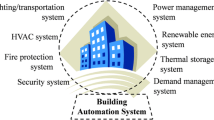Abstract
Improving the control strategy of building HVAC (heating, ventilation, and air-conditioning) systems can lead to significant energy savings while preserving human comfort requirements. This paper focuses on the analysis of the optimal control strategy of the whole HVAC system itself (such as set point value curves for different parts, number control curves of different components) and the followed operating curves of each equipment and device. In order to have a better understanding of the optimal control strategy, performances of the conventional control strategies widely used in China are also shown in this paper.
Similar content being viewed by others
References
Bertsekas DP (1995). Nonlinear Programming. New York: Athena Scientific.
Braun JE (1990). Reducing energy costs and peak electrical demand through optimal control of building thermal storage. ASHRAE Transactions, 96(2): 876–888.
Chow TT, Zhang GQ, Lin Z, Song CL (2002). Global optimization of absorption chiller system by genetic algorithm and neural network. Energy and Buildings, 34:103–109.
Congradac V, Kulic F (2009). HVAC system optimization with CO2 concentration control using genetic algorithms. Energy and Buildings, 41: 571–577.
DeST (2008). DeST-c User Manual. Beijing: Tsinghua University.
Felsmann C, Knabe G (2001). Simulation and optimal control strategies of HVAC systems. In: Proceedings of 7th International IBPSA Conference, Rio de Janeiro, Brazil, pp.1233–1239.
Flake BA (1998). Parameter estimation and optimal supervisory control of chilled water plants. PhD Dissertation, University of Wisconsin-Madison, USA.
Fong KF, Hanby VI, Chow TT (2006). HVAC system optimization for energy management by evolutionary programming. Energy and Buildings, 38: 220–231.
Hyvärinen J, Kärki S (1996). IEA Annex 25: Building Optimization and Fault Diagnosis Source Book. Espoo, Finland: Technical Research Centre of Finland.
Jin X, Ren H, Xiao X (2005). Prediction-based online optimal control of outdoor air of multi-zone VAV air conditioning systems. Energy and buildings, 37: 939–944.
Kintner-Meyer M, Emery AF (1995). Optimal control of an HVAC system using cold storage and building thermal capacitance. Energy and Buildings, 23: 19–31.
Kusiak A, Li M (2010). Cooling output optimization of an air handling unit. Applied Energy, 87: 901–909.
Kusiak A, Li M, Tang F (2010). Modeling and optimization of HVAC energy consumption. Applied Energy, 87: 3092–3102.
Kusiak A, Xu GL, Tang F (2011). Optimization of an HVAC system with a strength multi-objective particle-swarm algorithm. Energy, 36: 5935–5943.
Liang J, Du R (2008). Design of intelligent comfort control system with human learning and minimum power control strategies. Energy Conversion and Management, 49: 517–528.
Liu Y, Pan Y, Huang Z (2013). Simulation-based receding-horizon supervisory control of HVAC system. In: Proceedings of 13th International IBPSA Conference, Chambéry, France, pp.1492–1498.
Lu L, Cai W, Soh YC, Xie L (2005a). Global optimization for overall HVAC systems-Part II problem solution and simulations. Energy Conversion and Management, 46: 1015–1028.
Lu L, Cai W, Soh YC, Xie L (2005b). Global optimization for overall HVAC systems-Part I problem formulation and analysis. Energy Conversion and Management, 46: 999–1014.
Ma ZJ, Wang SW (2009). An optimal control strategy for complex building chilled water systems for practical and real-time applications. Building and Environment, 44: 1188–1198.
Massie DD (2002). Optimization of a building’s cooling plant for operating cost and energy use. International Journal of Thermal Sciences, 41: 1121–1129.
Mathews EH, Botha CP, Arndt DC, Malan A (2001). HVAC control strategies to enhance comfort and minimise energy usage. Energy and Buildings, 33: 853–863.
Nassif N, Kajl S, Sabourin R (2005). Optimization of HVAC control system strategy using two-objective genetic algorithm. HVAC & R Research, 11: 459–486.
Rink RE, Li N (1995). Aggregation/disaggregation method for optimal control of multizone HVAC systems. Energy Conversion and Management, 36: 79–86.
Sun J, Reddy A (2005). Optimal control of building HAVA&R systems using complete simulation-based sequential quadratic programming (CSR-SQP). Building and Environment, 40: 657–669.
Sun Y, Huang G, Li Z, Wang S (2013). Multiplexed optimization for complex air conditioning systems. Building and Environment, 65: 99–108.
Waltz RA, Morales JL, Nocedal J, Orban D (2006). An interior algorithm for nonlinear optimization that combines line search and trust region steps. Mathematical Programming, 107: 391–408.
Wang S (1999). Dynamic simulation of building VAV air-conditioning system and evaluation of EMCS on-line control strategies. Building and Environment, 34: 681–705.
Xue Z (2007). Energy-Saving Diagnosis and Retrofit in Existing Buildings. Beijing: China Architecture & Building Press. (in Chinese)
Yan D, Xia J, Tang W, Song F, Zhang X, Jiang Y (2008). DeST-An integrated building simulation toolkit, Part 1: Fundamentals. Building Simulation, 1: 95–110.
Yao Y, Chen J (2010). Global optimization of a central air-conditioning system using decomposition-coordination method. Energy and Buildings, 42: 570–583.
Zhang X, Xia J, Jiang Z, Huang J, Qin R, Zhang Y, Liu Y, Jiang Y (2008). DeST-An integrated building simulation toolkit, Part 2: Applications. Building Simulation, 1: 193–209.
Zheng GR, Zaheer-Uddin M (1996). Optimization of thermal processes in a variable air volume HVAC system. Energy, 21: 407–420.
Author information
Authors and Affiliations
Corresponding author
Rights and permissions
About this article
Cite this article
Liu, Z., Song, F., Jiang, Z. et al. Optimization based integrated control of building HVAC system. Build. Simul. 7, 375–387 (2014). https://doi.org/10.1007/s12273-014-0161-z
Received:
Revised:
Accepted:
Published:
Issue Date:
DOI: https://doi.org/10.1007/s12273-014-0161-z




